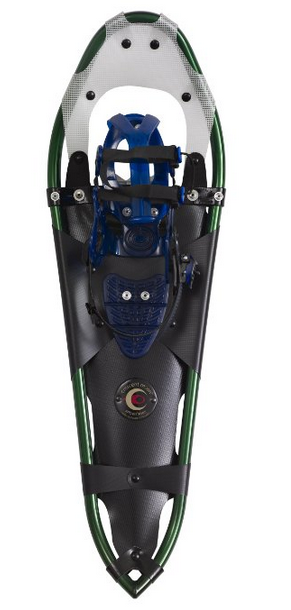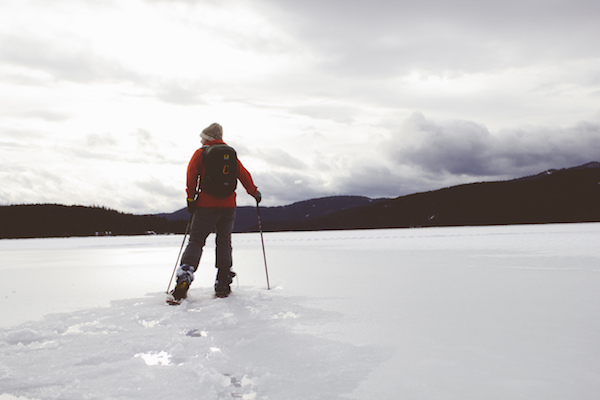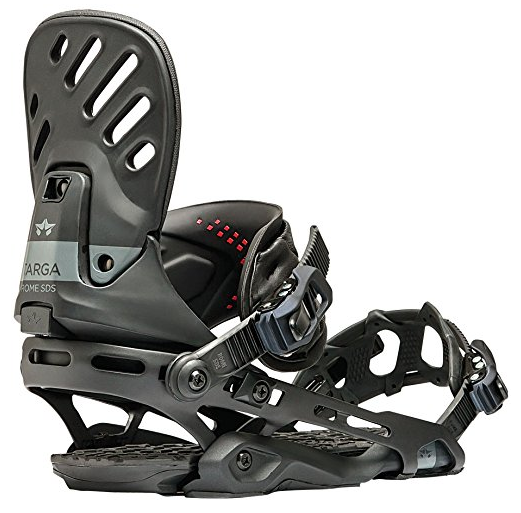 Snowshoes allow you to walk across snow covered grounding without sinking and let you experience the beauty of a hike in the snow and enjoy the beautiful winter scenery. Snowshoeing is also great exercise and not difficult to learn, so just about anyone can pick it up!
Snowshoes allow you to walk across snow covered grounding without sinking and let you experience the beauty of a hike in the snow and enjoy the beautiful winter scenery. Snowshoeing is also great exercise and not difficult to learn, so just about anyone can pick it up!
There are a few different types of snowshoes to choose from and they are used for different purposes. The three main types are rolling terrain shoes, mountain terrain shoes, and flat terrain shoes.
Rolling terrain shoes are best for hikers who have a bit of experience and will be hiking or backpacking on more difficult terrain, such as rolling or steep land. They have larger and thicker bindings and crampons, which are spiked metal plates on the bottom of the shoes. However, rolling terrain shoes are not meant for particularly steep or icy conditions that advanced backpackers would be hiking on. Expert hikers who regularly walk in icy or steep conditions should definitely choose mountain terrain shoes over rolling terrain shoes. If you will be hiking in areas without a set trail, you should also choose mountain terrain shoes. These shoes have more sustainable bindings and crampons that can endure even the worst conditions.
If you are just a beginner and do not think you will be blazing any trails just yet, you should look into flat terrain snowshoes. These snow shoes work best on flat ground, but not on steep or icy terrain. The bindings on these type of shoes are easily adjustable and the crampons are less intense or nonexistent. Additionally, there are some snow shoes that are designed specifically for certain activities, such as fitness or climbing.
Now lets look at what all you should consider when buying a new pair of snow shoes.
Bindings
The bindings ensure that the snow shoes attach directly to your regular shoes or boots with a series of straps. The two most common types of bindings are rotating or fixed bindings. Rotating bindings attach under the balls of your feet and pivot when you’re walking so as to move naturally with your gait. The amount that the bindings will move can depend on the shoe. If the bindings are attached with metal rods and have significant movement, it can help to reduce the weight and pressure on your legs by shedding the snow as you walk. One of the more negative aspects of rotating snowshoes is that it makes it extremely difficult to climb when an obstacle, such as a log or branch, appears in your way on your hike. These bindings can also make it more difficult to back up than others.
Fixed bindings do not rotate and are usually attached to the shoe with hefty rubber materials. Although fixed bindings do make it much easier to step over things and back up, the build up of the snow on your shoe, and kick it up on to the back of your legs, which can add extra weight and lead to your feet feeling tired.
 Snowshoe Traction
Snowshoe Traction
Snow shoes offer multiple traction devices to help you climb in difficult and snowy terrains. Flat terrain shoes made for beginners offer significantly less traction than those meant for more advanced hikers. Crampons are the most common traction device, but some shoes may also have bars or lifts to assist in this matter. Instep crampons are usually the most helpful in creating traction, as they are placed right under the bindings and help you pivot and find firm placement as you climb. Some shoes might also have heel crampons which are usually placed in a V formation and slow you down as you walk. Another device that may be placed near the heels are heel bars which flip down and give the feeling of walking up stairs which can provide some relief on the calf and prevent injury and fatigue. Side rails are another traction device that is meant to prevent sliding when you cross over slopes, while braking bars are meant to prevent falling backwards.
Snowshoe Sizing
Snowshoe sizing can depend on a lot of factors including your age, gender, the conditions you will be walking in, and your weight. Snow shoes do not generally come in typical shoe sizes. Aluminum frame snow shoes usually only come in several sizes, while composite snowshoes really only offer one size, but you have the option of adding tails if you need more support. The more weight you will be carrying, including the amount of equipment, the larger your snow shoes will need to be to support you and offer the right amount of traction.
It is also important to keep in mind the conditions that you will be traveling in. Bigger shoes often work best in powdery snow, while smaller shoes are better for packed trails or icy terrain. It is generally recommended to get the smallest shoes you can that will still adequately and efficiently hold your weight.
Do I Need Special Shoes?
It is not necessary to purchase special shoes to attach to your snow shoes. Most snow shoes can bind to just about any type of boot. There are some snow shoes that are more specifically designed for mountain boots or sneakers, although most are not that specific. Wear comfortable boots that are warm and fit well.
Top Recommended Snow Shoes
We’ve compiled a list of some of the best snow shoes available. We’ve included several different brands of shoes and some are men’s and some are women’s, but they all come highly recommended.
Men’s Crescent Moon Gold Series 10 Snowshoes
This pair of snow shoes stands out from others because the shape is slightly rounder. This shape may be preferential as it is less bulky and makes it easier and more comfortable to walk in. The Crescent Moon Gold Series 10 have a single pull loop binding system, which has been noted for its comfort and support, as well as three different stainless steel crampons which can lead to excellent traction in harsh conditions. Additionally, they have a cam buckle over the foot and a heel strap that allows for easy removal. Another feature that sets these shoes apart from other pairs is the toe claw which allows the wearer to dig in to hills and mountains and assists with push off when moving at faster speeds. They are also aluminum frame shoes, so they offer two different sizes. However,they are designed specifically for men. If you are environmentally conscious, there is an added bonus that these shoes are 95% recyclable. They come in two different color options; red or green. Although these are the priciest shoes on our list, many customers have found the extra money was well worth it for the quality of the shoe.
MSR Women’s Revo Explore Snowshoe
Many of the snow shoes on our list are made by MSR, so you know it is a quality brand. One of the great things about their Revo Explore shoe in particular is that it comes equipped with the ability to add a removable five inch tail, so you have the option for a smaller shoe when you need it, but can quickly switch to a larger shoe when you are carrying more weight. However, the tail is not included, which can be a drawback for some. These shoes offer an easy entry cradle, a two strap ratchet system, and a heel strap. They also have an easy to pull down heel bar, also known as a televator, which you can pull down to try to relieve some of the pressure on the legs and improve the traction. They come in two colors, blue and white, as well as two sizes. Many customers have stated that the binding is excellent and they are easy to slip on and off. Although this pair is also more expensive than some of the others, the quality and comfort seem to be worth it.
Tubbs Snowshoes Women’s FLEX TREK Snowshoe
These Tubbs Women’s Snowshoes are made of high quality aluminum so they are extremely durable and are offered in two sizes, the 22 inch and the 24 inch. The crampon on this shoe has a jagged teeth design so it offers an increased grip and traction that allows users to walk on difficult terrains, such as ice and packed snow. This pair comes with a quick flex binding that is made specifically for women and a heel strap that centers the boot. These are lightweight shoes that are not meant to carry a lot of weight, as the maximum capacity for the 22 inch is 155 pounds. The 24 inch pair can hold a bit more weight at 190 pounds. They come in two different colors so you have the option to choose between the pearl and blue and the grey and yellow. If you are looking for a lightweight shoe and do not carry a lot of equipment with you, this may be the perfect option for the price. Many previous customers were happy with how well these shoes worked with just about any boot in multiple sizes and that they were durable and very well made.
MSR Revo Trail Snowshoe
The MSR Revo Trail Snowshoe is specifically designed for rolling train, so these shoes might be too advanced for you if you are just a beginner, but they might not be ideal for harsh, icy conditions either. They have a particularly aggressive outer perimeter of teeth which makes for excellent traction. The duo-fit bindings are made to stand up to even the coldest of weather and are easy to take on and off, even when wearing gloves, which can be a huge help. They are also easy to wear over many different types of boots and shoes. The MSR Trail Snowshoe also has the ability to add a five inch tail if you will be carrying a heavy load. However, if you will not be, try to stick with the smallest size possible for convenience and easy walking. The tails are sold separately. These snowshoes only come in one rave green color, although you can choose between the 22 inch and 25 inch size depending on your weight and the amount of equipment you plan to carry. The current price for this pair ranges from $128.99 to $179.95. Many customers loved the lightweight feel of these snow shoes and that the floatation worked really well even for heavier users without the tail.
MSR Evo 22 Shoe
These MSR Evo 22 snowshoes offer a unibody traction system that has both steel traction rails and brake bars on the snowshoe decks to ensure a grip that you can be comfortable with when climbing uphill. Like many of the other MSR options on our list, it offers Duo Fit bindings that are easy to take on and off, can withstand harsh temperatures, and fit over several different types of footwear. They are extremely lightweight at only 3 pounds and 9 ounces per shoe. There are three color options so you can choose from red, mineral, or a darker blue. They do only come in one size and they do not have a heel lift to assist with the strain on the calves.
These are great for those who are looking to save some money, as they are currently only listed at $104.00. However, they are still very high quality and work really well according to many customer reviews. Additionally, you have the option to save more money by purchasing the accessories you might need with these shoes in a bundle pack. You can buy the pair of MSR Evo shoes with the five inch tails for added floatation, as well as the bag to carry all of this in for only $75 more dollars. However, if you do not feel that you will use the bag, it is also possible to just buy the snowshoes and the tails together. The tails will still cost extra as they are not included in the price of any of the MSR snow shoes on our list.

 Snowboarding is an awesome experience, but it takes a little preparation to be ready for the slopes. The first and most important piece of gear that you need to purchase is your snowboarding boots. Finding the right pair of boots is imperative, as your boots can be essentially what makes or breaks your experience on the mountain. If your feet are uncomfortable, your day will be miserable, so your goal is to find a pair of boots that fits both your needs and your style. Let’s start by narrowing down the options by pinpointing some characteristics that will help you zero in on the perfect snowboarding boots for you.
Snowboarding is an awesome experience, but it takes a little preparation to be ready for the slopes. The first and most important piece of gear that you need to purchase is your snowboarding boots. Finding the right pair of boots is imperative, as your boots can be essentially what makes or breaks your experience on the mountain. If your feet are uncomfortable, your day will be miserable, so your goal is to find a pair of boots that fits both your needs and your style. Let’s start by narrowing down the options by pinpointing some characteristics that will help you zero in on the perfect snowboarding boots for you.